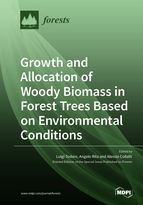Growth and Allocation of Woody Biomass in Forest Trees Based on Environmental Conditions
A special issue of Forests (ISSN 1999-4907). This special issue belongs to the section "Forest Ecology and Management".
Deadline for manuscript submissions: closed (10 July 2020) | Viewed by 39903
Special Issue Editors
Interests: wood characterization; extractives; natural resource management; wood modification
Special Issues, Collections and Topics in MDPI journals
Interests: plant ecology; tree growth; wood anatomy; dendrochronology; drought stress
Interests: forest modeling; climate change; climate change impacts; forest management scenario; carbon cycle; nitrogen cycle; climate change adaptation; climate change mitigation; forest ecology
Special Issues, Collections and Topics in MDPI journals
Special Issue Information
Dear Colleagues,
Terrestrial ecosystems, and forests in particular, are important components because of their key role in reducing atmospheric greenhouse gas concentrations by storing a large amount of carbon in biomass and soils. Increasing attention is being paid to forestland area, which accounts for 30% of the total land surface and acts as the main C store in the land system. In their life cycle, plants uptake, process, allocate, and remobilize resources from the environment, including basic materials, such as CO2, water, and nutrients, and other materials, such as sugars, proteins, and defensive chemicals. The relative amount of above- and belowground biomass allocated among leaves, branches, stems, roots, and reproductive tissues is a functional indicator of the forest stand and reflects the material flow, the wood quality, a plant’s survival strategy, and the primary production processes. The way in which plants share their labile products across their compartments is influenced by plant size and is not fixed but likely varies over time, across growth environments, and among species. It follows that the whole allocation process would be modulated under strong natural selection. Obtaining a qualitative/quantitative understanding of the influence that these factors have on growth and biomass allocation is of fundamental importance for both understanding plant ecology and evolution and developing environmental policies and forest management practices, such as:
- sequestration to increase stocks in more recalcitrant woody carbon pools, characterized by a slow build-up of carbon with a potentially slower release of carbon to the atmosphere;
- conservation to prevent emissions from existing forest carbon pools in regions with high C stocks and where natural disturbances are less frequent to cause large immediate reductions in C stocks;
- substitution of energy-intensive products with products derived from renewable resources; and
- the improvement of practices that aim to increase wood quality for social purposes.
Dr. Luigi Todaro
Dr. Angelo Rita
Dr. Alessio Collalti
Guest Editors
Manuscript Submission Information
Manuscripts should be submitted online at www.mdpi.com by registering and logging in to this website. Once you are registered, click here to go to the submission form. Manuscripts can be submitted until the deadline. All submissions that pass pre-check are peer-reviewed. Accepted papers will be published continuously in the journal (as soon as accepted) and will be listed together on the special issue website. Research articles, review articles as well as short communications are invited. For planned papers, a title and short abstract (about 100 words) can be sent to the Editorial Office for announcement on this website.
Submitted manuscripts should not have been published previously, nor be under consideration for publication elsewhere (except conference proceedings papers). All manuscripts are thoroughly refereed through a single-blind peer-review process. A guide for authors and other relevant information for submission of manuscripts is available on the Instructions for Authors page. Forests is an international peer-reviewed open access monthly journal published by MDPI.
Please visit the Instructions for Authors page before submitting a manuscript. The Article Processing Charge (APC) for publication in this open access journal is 2600 CHF (Swiss Francs). Submitted papers should be well formatted and use good English. Authors may use MDPI's English editing service prior to publication or during author revisions.
Keywords
- forest growth
- carbon allocation
- woody biomass
- wood quality








